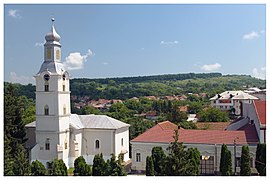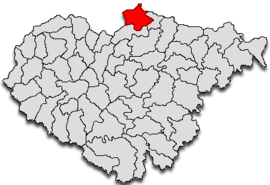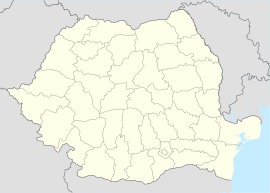
Târgu Secuiesc is a city in Covasna County, Transylvania, Romania. It administers one village, Lunga (Nyujtód).

Miercurea Nirajului is a town in Mureș County, Romania. It lies in the Székely Land, an ethno-cultural region in eastern Transylvania. The following seven villages are administered by the town: Beu (Székelybő), Dumitreștii (Demeterfalva), Lăureni (Kisszentlőrinc), Moșuni (Székelymoson), Șardu Nirajului (Székelysárd), Tâmpa (Székelytompa), and Veța (Vece).

Valea lui Mihai is a town in Bihor County, Crișana, Romania.

Treznea is a commune in Sălaj County, Crișana, Romania. It is composed of two villages, Bozna (Szentpéterfalva) and Treznea. These were part of Agrij Commune until 1995, when they were split off to form a separate commune.

Câțcău is a commune in Cluj County, Transylvania, Romania. It is composed of three villages: Câțcău, Muncel (Kishavas), and Sălișca (Szelecske).

Cojocna is a commune in Cluj County, Transylvania, Romania. It is composed of eight villages: Boj-Cătun, Boju (Kolozsbós), Cara (Kolozskara), Cojocna, Huci (Cserealja), Iuriu de Câmpie (Mezőőr), Moriști (Hurubák), and Straja (Szávatanya).

Vad is a commune in Cluj County, Transylvania, Romania. It is made up of seven villages: Bogata de Jos (Alsóbogáta), Bogata de Sus (Felsőbogáta), Calna (Kálna), Cetan (Csatány), Curtuiușu Dejului (Déskörtvélyes), Vad and Valea Groșilor (Tőkepataka).

Valcău de Jos is a commune in Sălaj County, Crișana, Romania. It is composed of six villages: Lazuri (Újvágás), Preoteasa (Füzespaptelek), Ratovei (Rátonbükk), Sub Cetate (Valkóváralja), Valcău de Jos, and Valcău de Sus (Felsővalkó). It is 14 km (8.7 mi) southwest of Șimleu Silvaniei.

Ghelința is a commune in Covasna County, Transylvania, Romania. It is composed of two villages, Ghelința and Harale (Haraly).

Coșeiu is a commune located in Sălaj County, Crișana, Romania. It is composed of three villages: Archid (Szilágyerked), Chilioara (Szilágykirva), and Coșeiu.
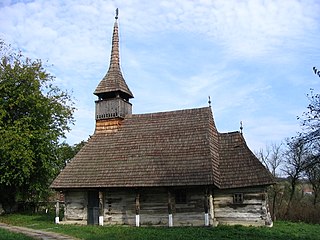
Chieșd is a commune located in Sălaj County, Crișana, Romania. It is composed of three villages: Chieșd, Colonia Sighetu Silvaniei (Szilágyszigettelep) and Sighetu Silvaniei (Szilágysziget).

Gârbou is a commune located in Sălaj County, Transylvania, Romania. It is composed of seven villages: Bezded (Bezdédtelek), Călacea (Kiskalocsa), Cernuc (Csernek), Fabrica (Cukorgyártelep), Gârbou, Popteleac (Paptelke), and Solomon (Gorbósalamon).

Crișeni is a commune in Sălaj County, Crișana, Romania. It consists of three villages: Crișeni, Cristur-Crișeni (Szilágyfőkeresztúr), and Gârceiu (Szilágygörcsön). Crișeni village was founded in 1387. The local economy consists of crafts, services, agriculture, trade, and tourism.

Măeriște is a commune located in Sălaj County, Crișana, Romania. It is composed of six villages: Criștelec (Kerestelek), Doh (Doh), Giurtelecu Șimleului (Somlyógyőrtelek), Măeriște, Mălădia (Maladé), and Uileacu Șimleului (Somlyóújlak).
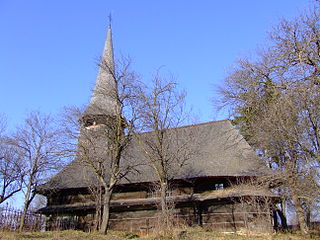
Someș-Odorhei is a commune located in Sălaj County, Crișana, Romania. It is composed of five villages: Bârsa (Dabjonújfalu), Domnin (Dabjon), Inău (Inó), Someș-Odorhei, and Șoimuș (Szilágysolymos).

Bichiș is a commune in Mureș County, Transylvania, Romania. It is composed of four villages: Bichiș, Gâmbuț (Gombostelke), Nandra (Lándor), and Ozd (Magyarózd).

Boiu Mare is a commune in Maramureș County, Transylvania, Romania. It is composed of four villages: Boiu Mare, Frâncenii Boiului (Frinkfalva), Prislop (Jóháza), and Românești (Szalmapatak).

Coroieni is a commune in Maramureș County, Transylvania, Romania. It is composed of five villages: Baba (Bába), Coroieni, Dealu Mare (Dombhát), Drăghia (Drágosfalva), and Vălenii Lăpușului (Dánpataka).

Bicaz is a commune in Maramureș County, Crișana, Romania. It is composed of three villages: Bicaz, Ciuta (Szilágynyires), and Corni (Somfalu).

Dragomirești is a town in Maramureș County, Maramureș, Romania. It was declared a town in 2004.
